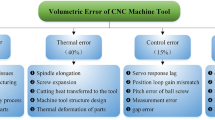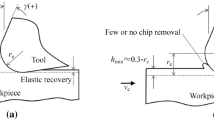Abstract
Active researches on milli-structures and micro-machines have been conducted in advanced countries, and micro-machining technology is one of the core items of the researches. The current technical backgrounds of micro-machining can be divided into semiconductor-based machining, such as lithography and etching, and conventional mechanical machining such as cutting, grinding, and electro-spark machining. The former can be limited due to their materials or thickness, and the latter, while having good productivity, suffer from a less-than superior finishing surface. Therefore, the cutting work could be reasonable in terms of superior productivity and a greater degree of freedom. Conventional ultra-high-precision cutting technology can be used for surface machining, but it has not yet been used to produce ultra-fine components. Therefore, researches on the preparation of ultra-highprecision micro-components in three-dimensional spaces with the milling technique using a single crystal diamond bite are underway. In this study, finite element analysis (FEA) was used to determine the safety and control performance of the micro-stage for the design of an elastic-hinge-type stage using a piezo-electric element.
Similar content being viewed by others
Abbreviations
- Fm:
-
main cutting force
- Fr:
-
radial/thrust cutting force
- Fa:
-
feed cutting force
- N:
-
shape function
- â :
-
parameter
- B :
-
deformation rate matrix
- E:
-
Young’s modulus
- v :
-
Poisson ratio
- σ ij :
-
stress
- ε ij :
-
deformation rate
- f e :
-
applied force
- K e :
-
element rigidity matrix
- a e :
-
knot parameter
References
Geyl, R., “Design and Fabrication of a Three-Mirror, Flat-Field Anastigmat for High-Resolution Earth Observation,” Proc. of SPIE, Vol. 2210, pp. 739–746, 1994.
Kim, J. Y., Lee, H. N., Kwac, L. K., Han, J. H., Cho, Y. T., and Jun, C. G., Control Performance Evaluation of Ultra Precision Positioning Apparatus,” Proc. of the International Symposium on Mechatronics and Intelligent Mechanical System for 21 Century, ISIM, pp. 252–255, 2000.
Shiraishi, M. and Uehara, K., “In-Process Control of Workpiece Dimension in Turning,” Annals of the CIRP, Vol. 28, No. 1, pp. 333–337, 1979.
Becker, P., Dorenwendt, K., Ebeling, G., Lauer, R., Lucas, W., et al., “Absolute Measurement of the (220) Lattice Plane Spacing in a Silicon Crystal,” Physical Review Letters, Vol. 46, No. 23, pp. 1540–1543, 1981.
Kim, H.-S. and Kim, E.-J., “Feed-Forward Control of Fast Tool Servo for Real-Time Correction of Spindle Error in Diamond Turning of Flat Surfaces,” International Journal of Machine Tools and Manufacture, Vol. 43, No. 12, pp. 1177–1183, 2003.
European Commission, Future and Emerging Technologies, http:// ec.europa.eu/programmes/horizon2020/en/h2020-section/future-andemerging-technologies (Accessed 7 SEP 2016)
Kohno, T., Okazaki, Y., Ozawa, N., Mitsui, K., and Omoda, M., Inprocess Measurement and a Workpiece-Referred Form Accuracy Control System (WORFAC): Concept of the Method and Preliminary Experiment,” Precision Engineering, Vol.11, No.1, pp. 9–14, 1989.
Falter, P. J., “Diamond Turning of Nonrotationally Symmetric Surfaces,” Dissertation Abstracts International, Vol. 51-04, Section: B, pp. 2019, 1990.
Patterson, S. R. and Magrab, E. B., “Design and Testing of a Fast Tool Servo for Diamond Turning,” Precision Engineering, Vol. 7, No. 3, pp. 123–128, 1985.
Donaldson, R. R. and Patterson, S. R., “Design and Construction of a Large, Vertical Axis Diamond Turning Machine,” Proc. of SPIE, Vol. 0443, pp. 62–67, 1983.
Ljubarsky, S. V., Sobolev, V. G., and Shevtsov, S. E., “Optical surface Fabrication on Ultraprecision Machines,” Proc. of SPIE, Vol. 1266, pp. 226–236, 1990.
Nakazawa, H., “Principles of Precision Engineering,” Oxford University Press, pp. 75–82, 140-167, 1994.
Smith, S. T. and Chetwynd, D. G., “Foundations of Ultra-Precision Mechanism Design,” pp. 95–128, 1992.
Keith Bowen, D., “Development in Nanotechnology,” Gordon and Breach Science Publishers, pp. 95–129, 1992.
Becker, E. B., Carey, G. F., and Oden, J. T., “Finite Elements, an Introduction: Volume I,” The University of Texas at Austin, pp. 242–245, 1981.
Author information
Authors and Affiliations
Corresponding author
Rights and permissions
About this article
Cite this article
Park, DK., Lee, GI., Gao, JC. et al. Research on the design of the ultra-high-precision positioning control error compensation. Int. J. Precis. Eng. Manuf. 17, 1351–1358 (2016). https://doi.org/10.1007/s12541-016-0160-3
Received:
Revised:
Accepted:
Published:
Issue Date:
DOI: https://doi.org/10.1007/s12541-016-0160-3




